
The Cattolica di Stilo is a Byzantine church in the comune of Stilo (Province of Reggio), Calabria, southern Italy. It is a national monument.

The Cattolica di Stilo is a Byzantine church in the comune of Stilo (Province of Reggio), Calabria, southern Italy. It is a national monument.
The Cattolica was built in the 9th century, when Calabria was part of the Byzantine Empire. The name derives from the Greek word katholiki, which referred to the churches provided with a baptistery. It is one of the most important examples of Byzantine architecture, together with the church of San Marco in Rossano Calabro.

The Cattolica is mainly built of brick. It follows a plan with "inscribed cross", typical of the middle Byzantine age. The interior is divided by four columns into five similar spaces. The square central space and the angled ones are covered by domes. The angled ones have tambours with the same diameter, while the central dome is slightly taller and larger.
The western sides lies on free rocks, while the southern area, ending with three apses, stands on three stone bases. The construction is in bricks.
The interior was once entirely covered with frescoes. The left apse has a bell built in 1577, when the church was converted to the Latin rite. The interior has also several inscriptions in Arabic, which have led scholars to suspect it could have been also used as a Muslim oratory. One inscription translates to "There is only one true God".

A mosaic is a pattern or image made of small regular or irregular pieces of colored stone, glass or ceramic, held in place by plaster/mortar, and covering a surface. Mosaics are often used as floor and wall decoration, and were particularly popular in the Ancient Roman world.

Byzantine architecture is the architecture of the Byzantine Empire, or Eastern Roman Empire, usually dated from 330 AD, when Constantine the Great established a new Roman capital in Byzantium, which became Constantinople, until the fall of the Byzantine Empire in 1453. There was initially no hard line between the Byzantine and Roman Empires, and early Byzantine architecture is stylistically and structurally indistinguishable from late Roman architecture. The style continued to be based on arches, vaults and domes, often on a large scale. Wall mosaics with gold backgrounds became standard for the grandest buildings, with frescos a cheaper alternative.
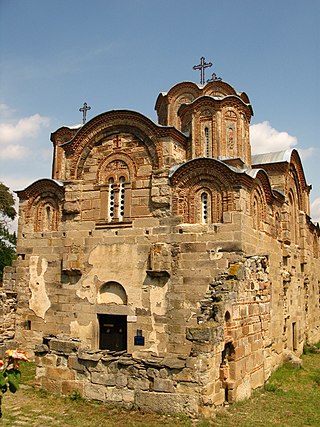
The Church of St. George is a Macedonian Orthodox church in the village of Staro Nagoričane, near Kumanovo in North Macedonia, built by medieval Serbian king Stefan Milutin. It is noteworthy both for its architecture and its frescoes. It is considered a 14th-century masterpiece of the palaiologan time and a key example of Christian heritage in this area.

Stilo is a town and comune in the province of Reggio Calabria, in the Calabria region of southern Italy. It is 151 kilometres (94 mi) from Reggio.

Hosios Loukas is a historic walled monastery situated near the town of Distomo, in Boeotia, Greece. Founded in the mid-10th century, the monastery is one of the most important monuments of Middle Byzantine architecture and art, and has been listed on UNESCO's World Heritage Sites since 1990, along with the monasteries of Nea Moni and Daphnion.

Fenâri Îsâ Mosque, known in Byzantine times as the Lips Monastery, is a mosque in Istanbul, made of two former Eastern Orthodox churches.

The Pammakaristos Church, also known as the Church of Theotokos Pammakaristos, is one of the most famous Byzantine churches in Istanbul, Turkey, and was the last pre-Ottoman building to house the Ecumenical Patriarchate. Converted in 1591 into the Fethiye Mosque, it is today partly a museum housed in a side chapel or parekklesion. One of the most important examples of Constantinople's Palaiologan architecture, the church contains the largest quantity of Byzantine mosaics in Istanbul after the Hagia Sophia and The Chora.
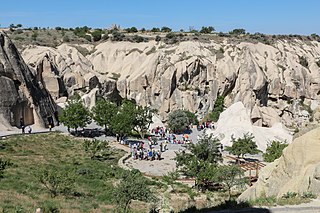
Göreme is a district of the Nevşehir Province in Turkey. After the eruption of Mount Erciyes about 2.6 million years ago, ash and lava formed soft rocks in the Cappadocia region, covering a region of about 20,000 square kilometres (7,700 sq mi). The softer rock was eroded by wind and water, leaving the hard cap rock on top of pillars, forming the present-day fairy chimneys. People of Göreme, at the heart of the Cappadocia region, realized that these soft rocks could be easily carved out to form houses, churches, and monasteries. These Christian sanctuaries contain many examples of Byzantine art from the post-iconoclastic period. These frescos are a unique artistic achievement from this period.
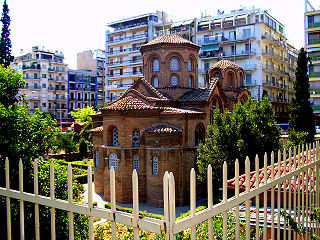
A cross-in-square or crossed-dome plan was the dominant architectural form of middle- and late-period Byzantine churches. It featured a square centre with an internal structure shaped like a cross, topped by a dome.

Samtavisi is an eleventh-century Georgian Orthodox cathedral in eastern Georgia, in the region of Shida Kartli, some 45 km from the nation's capital Tbilisi, near Igoeti village. The cathedral is now one of the centers of the Eparchy of Samtavisi and Gori of the Georgian Orthodox Church. The church is a typical example and the founder of the Georgian interpretation of the cross-in-square churches. It was built in the period of decorative and artistic bloom in the architecture of Georgia.
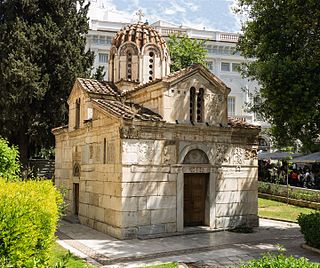
The Little Metropolis, formally the Church of St. Eleftherios or Panagia Gorgoepikoos, is a Byzantine church located at the Mitropoleos Square, next to the Metropolitan Cathedral of Athens.

The Cathedral of Talin is a seventh-century Armenian cathedral located in the cemetery of Talin, in the Aragatsotn Province of Armenia.
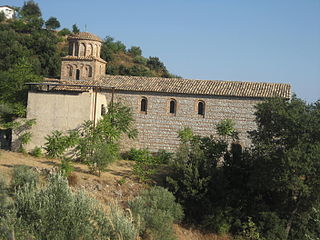
The Monastery of San Giovanni Theristis Greek: Ιερά Μονή Αγίου Ιωάννη του Θεριστή, is an Orthodox Christian monastery in Bivongi, Calabria, southern Italy. It is part of the Romanian Orthodox Diocese for Italy.

The church of St. Euphemianos is a small medieval church, about 2 km to the southwest of the village of Lysi in the Famagusta district of Cyprus. It is a very small, single-dome, stone building and the interior is decorated with frescoes dating back to the 13th and 14th centuries.
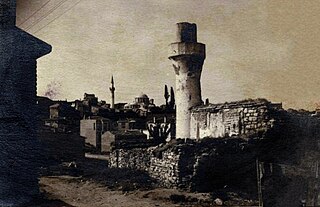
The Odalar Mosque was an Ottoman mosque in Istanbul. The building was originally a Byzantine-era Eastern Orthodox church of unknown dedication. In 1475, after the Fall of Constantinople (1453), it became a Roman Catholic church, dedicated to Saint Mary of Constantinople, until finally it was converted into a mosque by the Ottomans in 1640. The mosque was destroyed by fire in 1919, and since then has fallen into ruin. As of 2011, only some walls remain, hidden among modern buildings.

The Church of St. George is a 12th-century Macedonian Orthodox church located 2 km away from the village of Kurbinovo in North Macedonia. Excavations have shown that the building has once belonged to a settlement, which was abandoned at the end of the 18th century for the present-day village of Kurbinovo. According to the research made on the church's frescoes, it is supposed that the church was built in the year 1191 by the Byzantines. The church is a "monument of culture" in the Republic of North Macedonia and protected by law. It is also a part of the Prespa - Pelagonia diocese of the Macedonian Orthodox Church.

The early domes of the Middle Ages, particularly in those areas recently under Byzantine control, were an extension of earlier Roman architecture. The domed church architecture of Italy from the sixth to the eighth centuries followed that of the Byzantine provinces and, although this influence diminishes under Charlemagne, it continued on in Venice, Southern Italy, and Sicily. Charlemagne's Palatine Chapel is a notable exception, being influenced by Byzantine models from Ravenna and Constantinople. The Dome of the Rock, an Umayyad Muslim religious shrine built in Jerusalem, was designed similarly to nearby Byzantine martyria and Christian churches. Domes were also built as part of Muslim palaces, throne halls, pavilions, and baths, and blended elements of both Byzantine and Persian architecture, using both pendentives and squinches. The origin of the crossed-arch dome type is debated, but the earliest known example is from the tenth century at the Great Mosque of Córdoba. In Egypt, a "keel" shaped dome profile was characteristic of Fatimid architecture. The use of squinches became widespread in the Islamic world by the tenth and eleventh centuries. Bulbous domes were used to cover large buildings in Syria after the eleventh century, following an architectural revival there, and the present shape of the Dome of the Rock's dome likely dates from this time.

Aghaiani church of Saint Nino is an early medieval Georgian Orthodox church on Mount Tkhoti, 2 km southeast of the village of Aghaiani in the Kaspi Municipality in Georgia's Shida Kartli region. It stands at the place of one of the three wooden crosses erected—according to historical tradition—at the behest of Saint Nino to mark adoption of Christianity by the people of Kartli. The extant structure is a hall church, a 9th–10th-century remodeling of an earlier cross-in-square building. The church is inscribed on the list of Georgia's Immovable Cultural Monuments of National Significance.

The Ruisi cathedral of the Mother of God is a Georgian Orthodox church in the village of Ruisi in Georgia's east-central Shida Kartli region. Originally built in the 8th–9th century, the church was remodeled in the 11th century and rebuilt in the 15th century. It is a cross-in-square church with a tall dome and a horseshoe apse on the east. The cathedral is inscribed on the list of Georgia's Immovable Cultural Monuments of National Significance.
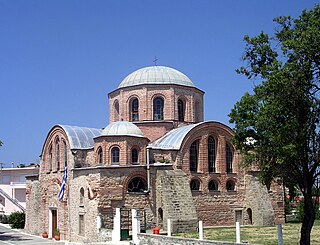
The Theotokos Kosmosoteira is a Greek Orthodox monastery in Feres, Evros Prefecture, Greece. It was built around 1152 by the sebastokrator Isaac Komnenos, a son of the Byzantine emperor Alexios I Komnenos. The monastery became the core of the settlement of Feres, but is last attested in the mid-14th century. By the 15th-century, under the Ottoman Empire, the complex was a mosque; it again became a church in 1940.